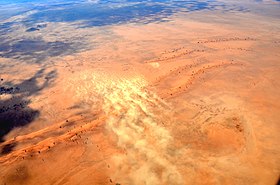
| Dust storm | |
|---|---|
 A sandstorm approaching Al Asad April 27, 2005. | |
| Effect | May cause coughing and spread dust. |
| Part of a series on |
| Weather |
|---|
|
|
A dust storm, also called a sandstorm, is a meteorological phenomenon common in arid and semi-arid regions.[1] Dust storms arise when a gust front or other strong wind blows loose sand and dirt from a dry surface. Fine particles are transported by saltation and suspension, a process that moves soil from one place and deposits it in another.
The arid regions of North Africa, the Middle East, Central Asia and China are the main terrestrial sources of airborne dust. It has been argued that[2][unreliable source?] poor management of Earth's drylands, such as neglecting the fallow system, are increasing the size and frequency of dust storms from desert margins and changing both the local and global climate, as well as impacting local economies.[3]
The term sandstorm is used most often in the context of desert dust storms, especially in the Sahara Desert, or places where sand is a more prevalent soil type than dirt or rock, when, in addition to fine particles obscuring visibility, a considerable amount of larger sand particles are blown closer to the surface. The term dust storm is more likely to be used when finer particles are blown long distances, especially when the dust storm affects urban areas.
- ^ "Airborne Dust: A Hazard to Human Health, Environment and Society". WMO – Bulletin: Vol 64 (2) – 2015. 2022. Archived from the original on December 18, 2023.
- ^ Eslamian, Saeid; Eslamian, Faezeh (2017). Handbook of Drought and Water Scarcity: Management of Drought and Water Scarcity. CRC Press. ISBN 978-1-351-85113-8. Retrieved 4 December 2017.
- ^ Squires, Victor R. "Physics, Mechanics and Processes of Dust and Sandstorms" (PDF). Adelaide University, Australia. Archived (PDF) from the original on 2015-06-05. Retrieved 2007-07-29.